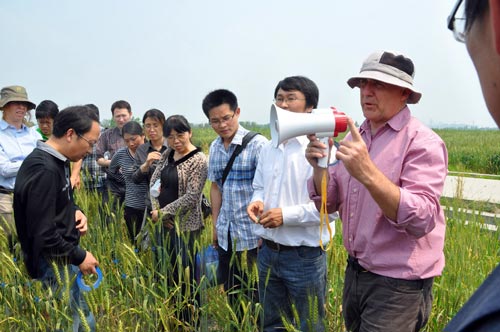 One of the worst wheat diseases in China, stripe rust has appeared in yearly epidemics since 1950 and caused losses of more than 60 million tons. As China is among the world’s main producers of wheat, the CIMMYT China office in Chengdu, in collaboration with the Sichuan Academy of Agricultural Sciences (SAAS), organized a two-day workshop to address these issues.
One of the worst wheat diseases in China, stripe rust has appeared in yearly epidemics since 1950 and caused losses of more than 60 million tons. As China is among the world’s main producers of wheat, the CIMMYT China office in Chengdu, in collaboration with the Sichuan Academy of Agricultural Sciences (SAAS), organized a two-day workshop to address these issues.
On 23 April 2012, around 50 participants from Sichuan and neighboring provinces were joined at SAAS by representatives from the Sichuan Department of Science and Technology and the Foreign Expert Bureau of Sichuan Province. The purpose of the workshop, which included site visits, was to learn about breeding for durable resistance to stripe rust in wheat.
Following an introduction by SAAS vice president Liu Jianjun, the workshop began with several seminars on breeding and rust diseases. Professor Bob McIntosh from Sydney University, Australia, presented a seminar on host pathogen interactions and the current status of global rust
epidemics, followed by CIMMYT scientist Sybil Herrera who gave an update on her work with minor, durable resistance genes, marker development and their application in breeding programs. CIMMYT wheat breeder Garry Rosewarne outlined some of the work on quantitative trait locus (QTL) analysis and breeding strategies at SAAS. Ennian Yang from SAAS closed with an account of CIMMYT SAAS collaborations, outlining the early shuttle breeding between China and Mexico and related outcomes.
The rest of the workshop was dedicated to field visits, with two sites visited on the first day. At Xindu farm, the main SAAS breeding site, the participants saw demonstrations of the selected bulk methodology. At the Guanghan site there were several elite yield trials as well as seed multiplication blocks of the latest, high-yielding releases from another Sichuan based breeder, Dr Wuyun Yang. During discussions, Dr Tang, a local agronomist, also explained conservation agriculture techniques developed in collaboration with CIMMYT’s consultant Ken Sayre. In traditional Chinese fashion, the evening was spent at a banquet at the “One Duck” restaurant, with everyone enjoying excellent food and wine, and catching up with old friends.
The second day of the workshop involved a visit to the field station of the Neijiang Academy of Agricultural Sciences, hosted by their president Huang Yuecheng. Based in a mountainous region near Chengdu, there were interesting demonstrations of intercropping with high-yielding wheat and specially designed equipment for cultivation and sowing on small, hilly plots. The main purpose of this field visit however was to see the academy’s own variety, Neimai 836, which has high yield potential and good resistance to powdery mildew (Pm21) as well as stem rust resistance against Ug99.
 Capacity development
Capacity development